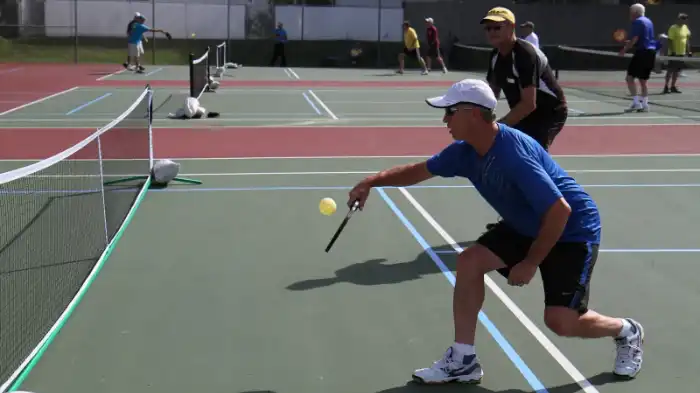Pickleball is a popular racquet sport which combines elements of tennis, badminton, and ping pong. It is played with a paddle and a plastic ball on a court divided into two sides by a net. Just like in other sports, there are rules and regulations that players must follow to ensure fair play.
One important rule in pickleball is avoiding a foot fault. In this blog post, we will explore what a Foot Fault in Pickleball, how it is determined, and the consequences of committing a foot fault.
Understanding Foot Fault in Pickleball
A Foot Fault in Pickleball occurs when a player steps on or beyond the baseline before or during their serve, or when the server fails to keep one foot behind the baseline during the serve. The baseline is the back boundary line on each side of the pickleball court. In simpler terms, it is an infringement of the rules regarding the server’s position during the serve.

Foot faults are generally called by the opponent, but the referee or line judge can also spot them. The server may unintentionally commit a foot fault if they are not aware of their positioning on the court. However, some players intentionally commit foot faults to gain an advantage, which is against the spirit of the game.
Determining a Foot Fault
To determine a Foot Fault in Pickleball, the server’s feet must be behind the baseline when the serve is initiated. The other foot must remain behind the baseline until the ball is struck. If any part of the server’s foot touches or crosses the baseline, it is considered a foot fault. If a player steps on or beyond the baseline while serving, it is also a foot fault.
Referees and line judges closely monitor the server’s position during the serve. They pay attention to the server’s feet and any potential violations. However, in some cases, it can be difficult to call a foot fault accurately, especially at a high level of play where the serving motion happens quickly. In competitive matches, officials may use instant replay to review serves and determine if a foot fault occurred.
Consequences of Committing a Foot Fault
Committing a foot fault in pickleball has consequences that vary depending on the playing level and type of match. In recreational play, it is common to let the foot fault slide, especially if the players are still learning the game. However, it is important to be consistent with the rules to ensure fair play and avoid confusion.
In more competitive settings, a foot fault results in a fault, and the server loses the serve. This means that the server’s team does not earn a point, and the serve is handed over to the opposing team. In some cases, repeated foot faults can lead to disqualification from the match or tournament.
Tips to Avoid Foot Faults
Here are some tips to help you avoid committing a foot fault during your pickleball serves:
1. Know the Rules:
Make sure you are familiar with the rules regarding foot faults. Knowing the rules will help you understand what constitutes a foot fault and how to avoid it.
2. Practice Proper Foot Positioning:
During your practice sessions, pay attention to your foot positioning. Practice proper foot placement behind the baseline to develop good habits and muscle memory.

3. Maintain Your Balance:
Balance is crucial when serving in pickleball. Focus on maintaining a stable base to avoid unintentionally stepping on or beyond the baseline.
4. Seek Feedback:
Ask your practice partner or coach to keep an eye on your foot positioning during serves. Their feedback can help you identify and correct any potential foot faults.
Conclusion
Foot Fault in Pickleball can impact the fairness and integrity of the game. It is essential for players to be aware of their positioning during serves and avoid foot faults. By understanding the rules, practicing proper foot positioning, maintaining balance, and seeking feedback, players can minimize the risk of foot faults. Remember, fair play is key to enjoying the sport and competing with sportsmanship.
Frequently Asked Questions
A foot fault in pickleball occurs when a player steps on or over the baseline or the non-volley zone (kitchen) line during a serve or during a rally before hitting the ball. It results in a point being awarded to the opposing team or a fault being called if the player is serving.
Foot faults are determined by the referee or the player’s opponent(s) observing the player’s feet during the serve or rally. If any portion of the player’s foot touches or crosses the line before the ball is struck, it is considered a foot fault.
In most cases, when a foot fault is called, it results in a fault for the serving team, resulting in a loss of serve or a point awarded to the opposing team. If a foot fault occurs during a rally, it would also result in a fault, with the opposing team receiving the point.
In general, foot faults in pickleball are clear-cut rules with few exceptions. However, there are specific circumstances where the referee may give some leeway if the player accidentally touches or crosses the line due to momentum or slipping on the court. It is always important to consult the official pickleball rulebook for any variations in rules during tournaments or special events.
To avoid foot faults, players should be mindful of their positioning on the court during serves and rallies. For the serve, it is crucial to ensure that both feet are behind the baseline and that they do not touch or cross the line until after the ball is struck. During rallies, players must be aware of their proximity to the non-volley zone line, especially when hitting shots close to the net. Practicing footwork and maintaining balance can also help prevent accidental foot faults in pickleball.

